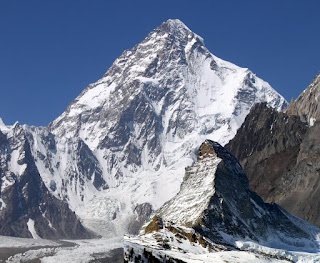 |
| A scale comparison of the Matterhorn and K2 gives an impression of the massive size of K2. |
There are a number of routes on K2, of somewhat different character, but they all share some key difficulties. First, of course, is the extreme high altitude and resulting lack of oxygen: there is only one-third as much oxygen available to a climber on the summit of K2 as there is at sea level. Second is the propensity of the mountain to experience extreme storms of several days' duration, which have resulted in many of the deaths on the peak. Third is the steep, exposed, and committing nature of all routes on the mountain, which makes retreat more difficult, especially during a storm. Despite many attempts there have been no successful winter ascents. All major climbing routes lie on the Pakistani side, which is also where the base camp is located
Abruzzi Spur
The standard route of ascent, used far more than any other route, is the Abruzzi Spur, located on the Pakistani side, first attempted by Luigi Amedeo, Duke of the Abruzzi in 1909. This is the southeast ridge of the peak, rising above the Godwin Austen Glacier. The spur proper begins at an altitude of 5,400 metres (17,700 ft), where Advanced Base Camp is usually placed. The route follows an alternating series of rock ribs, snow/ice fields, and some technical rock climbing on two famous features, "House's Chimney" and the "Black Pyramid." Above the Black Pyramid, dangerously exposed and difficult to navigate slopes lead to the easily visible "Shoulder", and thence to the summit. The last major obstacle is a narrow couloir known as the "Bottleneck", which places climbers dangerously close to a wall of seracs which form an ice cliff to the east of the summit. It was partly due to the collapse of one of these seracs around 2001 that no climbers summitted the peak in 2002 and 2003.
On August 1, 2008, a number of climbers went missing when a serac in the Bottleneck snapped and broke their ropes. Survivors were seen from a helicopter, but rescue efforts were impeded by the high altitude. Eleven were never found, and presumed dead.
 |
| Climbing ladders on Abruzzi Spur |
Almost opposite from the Abruzzi Spur is the North Ridge, which ascends the Chinese side of the peak. It is rarely climbed, partly due to very difficult access, involving crossing the Shaksgam River, which is a hazardous undertaking. In contrast to the crowds of climbers and trekkers at the Abruzzi basecamp, usually at most two teams are encamped below the North Ridge. This route, more technically difficult than the Abruzzi, ascends a long, steep, primarily rock ridge to high on the mountain — Camp IV, the "Eagle's Nest" at 7,900 metres (25,900 ft) — and then crosses a dangerously slide-prone hanging glacier by a leftward climbing traverse, to reach a snow couloir which accesses the summit.
Besides the original Japanese ascent, a notable ascent of the North Ridge was the one in 1990 by Greg Child, Greg Mortimer, and Steve Swenson, which was done alpine style above Camp 2, though using some fixed ropes already put in place by a Japanese team.
 |
| The north side of K2. The North Ridge is in the centre of the picture. |
- Northeast Ridge (long and corniced; finishes on uppermost part of Abruzzi route), 1978.
- West Ridge, 1981.
- Southwest Pillar or "Magic Line", very technical, and second most demanding. First climbed in 1986 by the Polish-Slovak trio Piasecki-Wróż-Božik. Since then the Catalan Jordi Corominas was the only successful climber on this route, despite many other attempts.
- South Face or "Polish Line" (extremely exposed and most dangerous). In 1986, Jerzy Kukuczka and Tadeusz Piotrowski summitted on this route. Reinhold Messner called it a suicidal route and no one has repeated their achievement. "The route is so avalanche-prone, that no one else has ever considered a new attempt."
- Northwest Face, 1990.
- Northwest Ridge (finishing on North Ridge). First ascent in 1991.
- South-southeast spur or "Cesen route" (finishing on Abruzzi route — possibly safer alternative to the Abruzzi Spur, because it avoids Black Pyramid, the first big obstacle on Abruzzi), 1994.
 |
| The major routes to have been climbed on the south side of the mountain. A:West Ridge B:West Face C:Southwest Pillar D:South Face E:South-southeast Spur F: Abruzzi Spur |
For most of its climbing history, K2 was not usually climbed with bottled oxygen, and small, relatively lightweight teams were the norm. However the 2004 season saw a great increase in the use of oxygen: 28 of 47 summiteers used oxygen in that year.
Acclimatisation is essential when climbing without oxygen to avoid some degree of altitude sickness.[43] K2's summit is well above the altitude at which high altitude pulmonary edema (HAPE), or high altitude cerebral edema (HACE) can occur, above the 8000-metre altitude that marks the boundary of the "death zone."


 1:09 AM
1:09 AM
 Unknown
Unknown

 Posted in:
Posted in:
0 comments:
Post a Comment